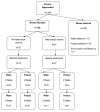Infant skin-cleansing product versus water: a pilot randomized, assessor-blinded controlled trial
- PMID: 21569487
- PMCID: PMC3112109
- DOI: 10.1186/1471-2431-11-35
Infant skin-cleansing product versus water: a pilot randomized, assessor-blinded controlled trial
Abstract
Background: The vulnerability of newborn babies' skin creates the potential for a number of skin problems. Despite this, there remains a dearth of good quality evidence to inform practice. Published studies comparing water with a skin-cleansing product have not provided adequate data to inform an adequately powered trial. Nor have they distinguished between babies with and without a predisposition to atopic eczema. We conducted a pilot study as a prequel to designing an optimum trial to investigate whether bathing with a specific cleansing product is superior to bathing with water alone. The aims were to produce baseline data which would inform decisions for the main trial design (i.e. population, primary outcome, sample size calculation) and to optimize the robustness of trial processes within the study setting.
Methods: 100 healthy, full term neonates aged <24 hours were randomly assigned to bathing with water and cotton wool (W) or with a cleaning product (CP). A minimum of bathing 3 times per week was advocated. Groups were stratified according to family history of atopic eczema. Transepidermal water loss (TEWL), stratum corneum hydration and skin surface pH were measured within 24 hours of birth and at 4 and 8 weeks post birth. Measurements were taken on the thigh, forearm and abdomen. Women also completed questionnaires and diaries to record bathing practices and medical treatments.
Results: Forty nine babies were randomized to cleansing product, 51 to water. The 95% confidence intervals (CI) for the average TEWL measurement at each time point were: whole sample at baseline: 10.8 g/m(2)/h to 11.7 g/m(2)/h; CP group 4 weeks: 10.9 g/m(2)/h to 13.3 g/m(2)/h; 8 weeks: 11.4 g/m(2)/h to 12.9 g/m(2)/h; W group 4 weeks:10.9 g/m(2)/h to 12.2 g/m(2)/h; 8 weeks: 11.4 g/m(2)/h to 12.9 g/m(2)/h.
Conclusion: This pilot study provided valuable baseline data and important information on trial processes. The decision to proceed with a superiority trial, for example, was inconsistent with our data; therefore a non-inferiority trial is recommended.
Figures
References
-
- Irving V. Caring for and protecting the skin of pre-term neonates. J Wound Care. 2001;10:253–6. - PubMed
-
- Atherton D, Mills K. What can be done to keep babies skin healthy? RCM Midwives Journal. 2004;7(7):288–90. - PubMed
-
- National Institute of Clinical Excellence. National Collaborating Centre for Women's and Children's Health. London; 2006. Postnatal care guidelines. - PubMed
-
- AWHONN. Neonatal Skin Care: Evidence Based Clinical Practice Guidelines. 2. Washington; 2007.
Publication types
MeSH terms
Substances
Associated data
LinkOut - more resources
Full Text Sources
Medical
Miscellaneous


